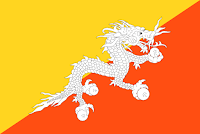Bhutan (Dzongkha: འབྲུག་ཡུལ་, / Druk Yul),
officially the Kingdom of Bhutan (Dzongkha: འབྲུག་རྒྱལ་ཁབ་, /Druk Gyal Khap), is a
landlocked country in South Asia. Located in the Eastern Himalayas, it is bordered by the Tibet Autonomous Region of
China in the north, the Chumbi Valley of Tibet, China and the Indian states of Sikkim
and West Bengal in the west, and the Indian states of Assam,
West Bengal and Arunachal Pradesh in the south and east. Bhutan is
geopolitically in South Asia and is the region's
second-least-populous nation after the Maldives. Thimphu is its capital and largest city,
while Phuntsholing is its financial center. Bhutan's independence
has endured for centuries. It has never been colonized in its history. Situated on the ancient Silk Road between Tibet, the Indian subcontinent and Southeast Asia, the Bhutanese state developed a distinct national identity based on Buddhism. In South Asia, Bhutan ranks first in economic freedom, ease of doing business,
and peace, and is the least corrupt country
in the region as of 2016. It continues to be a least developed country,
but expects to graduate from this status by 2023. Hydroelectricity accounts for
most of its exports. The government is a
parliamentary democracy; the head of state is the King of Bhutan,
known as the "Dragon King." The precise etymology
of "Bhutan" is unknown, although it is likely to derive from the Tibetan endonym "Böd" for Tibet.
Traditionally, it is taken to be a transcription of the Sanskrit Bhoṭa-anta "end of Tibet",
a reference to Bhutan's position as the southern extremity of the Tibetan
plateau and culture.
Since the 17th century
Bhutan's official name has been Druk yul (country of the Drukpa Lineage, the Dragon People, or the Land of the Thunder
Dragon, a reference to the country's dominant Buddhist sect);
"Bhutan" appears only in English-language official correspondence.
The first postage stamps of Bhutan were issued in 1962, the same year that the first motorable
road was opened. Before that there was a
mail delivery system in place for official mail using mail runners, and between 1955 and 1962 revenue stamps were accepted as payment for internal mail.
With the opening up of Bhutan in the early 1960s, a formal postal system was
introduced. The American entrepreneur Burt Todd assisted in establishing a
postage stamp program in the country and Bhutan became known for the unusual
designs and materials of its stamps which were chosen by Todd specifically to
attract attention. With the assistance of the Indian postal advisor Dr. K.
Ramamurti, who was in Bhutan from 1964 to 1968, a proper postal organization
and infrastructure was set up under the leadership of a young Bhutanese officer
Mr. Lam Penjor, who became the Director of the Department of Posts and
Telegraphs.
Most of the known covers
sent via this route were destined for the Bhutanese representation in Kalimpong, India, known as Bhutan House. However, covers to private people and people c/o
the post office in Kalimpong are known, as are covers to more far flung
locations in India, Nepal, the UK and the USA. A few covers without additional
stamps of other countries are known to have made it to their destinations in
the USA. Generally, on items going abroad, the fiscal stamps appear affixed at
the upper left of the dual franked covers, with space left at the upper right
where eventually the Indian or Chinese stamps purchased at Yatung were placed,
resulting in mixed franking. Some
covers have the added postage on the backsides. Although disputed, the Finnish
philatelist Iiro Kakko opines that the majority of the known covers sent to
Kalimpong appear not to be genuine letters routed through the postal system,
but especially produced for the philatelic market.
In 1974, the Department of
Posts & Telegraphs appointed the Inter-Governmental
Philatelic Corporation (IGPC), based in New York, as its sole,
worldwide agent that permitted IGPC to design and print stamps against a
royalty. One particular initiative of the P&T Department after the
introduction of this new policy was the release in May 1993 of the Famous
Paintings - Reading & Writing issue, originally designed and printed by the
Bhutan Stamp Agency to commemorate the 100th Anniversary of the UPU (1874–1974)
and prepared by the agency to be issued in late 1974. However, the termination
of their contract intervened, while the stamps had been already shipped to
Bhutan. Since their arrival in the country, the stamps were kept in customs
storage and reportedly forgotten by the P&T Department until the early
1990s.
On 14 February 1982 Bhutan
joined the Asian-Pacific Postal Union
(APPU). With the introduction of Druk Air services between Bhutan, India and Thailand in 1991,
mail no longer needed to be routed only overland via Phuentsholing to India,
but could also directly be exchanged with the postal exchange offices of New
Delhi, Kolkata and Bangkok. n the 7th Five Year Plan
(1992–97) privatization of businesses directly ran by the government was one of
the major objectives. As a result, the postal and telegraph activities of the P
& T Department were incorporated in an autonomous corporation, the Bhutan
Postal Corporation Ltd., with its trade name Bhutan Post, as of 1 October 1996.









No comments:
Post a Comment
Note: only a member of this blog may post a comment.